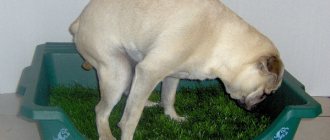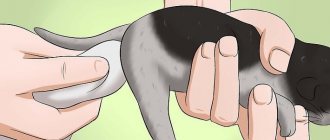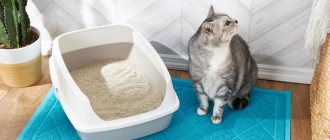In the event that an adult meowing creature appears unplanned in your apartment, as a rule, a huge number of questions arise that must be resolved as quickly as possible. For example, one of them sounds like this: how to train an adult cat to use a litter box?
For many cat owners, the animal’s refusal to use the litter box becomes a significant incentive to achieve their goal.
People often believe that male cats place their scent marks outside the litter box as revenge on their owner. However, this is not always the case. It’s just that, as a rule, in this way the pet “fights” something that worries him. By spreading its scent, which is soothing for it, throughout the house, the animal thereby, as it were, eliminates the imaginary cause of its worries. One of the factors causing anxiety in a pet can be either the mating season (if the cat is not castrated or the cat is sterilized), or an unacceptable atmosphere for the animal in certain places in the apartment. Despite the above, you should not panic if you were unable to solve a household problem the first time - how to train an adult cat to use the litter box.
It is important to choose the right place for your cat to go to the toilet.
How to accustom a kitten to a litter tray
The easiest way to train a small kitten to use a litter tray. If he lives with a cat mother, this problem can be easily solved by a caring parent who sets a good example for the younger generation. Already at the age of two months, a kitten watching the mother cat go to the toilet will understand the main purpose of the tray and will independently go there when needed.
If a kitten is separated from its mother, the new owners will have to train it to use the litter box. In cats, the physiological desire to go to the toilet occurs after waking up and eating. At first, you can put the kitten on the tray immediately after feeding and sleeping. If he relieves himself in the toilet, be sure to praise him.
Not all kittens quickly get used to the toilet. Many of them relieve themselves on the floor. You should not scold the baby, since he does not yet understand what is causing the owner’s aggressive behavior. The best solution is to wash off the urine with a dry cloth, which can be placed in a tray intended for the toilet. The cat can recognize the right place by smell.
Sometimes kittens fundamentally do not want to go to the toilet where the tray is located, and relieve their need in a certain corner of the apartment. Try moving the tray to this location. Perhaps the baby will like it and he will stop peeing on the floor.
If the kitten goes to the toilet on upholstered furniture or in a closet, you will have to buy a special repellent to wean it from the bad habit.
When training your kitten to use the litter box, be patient. If you do everything correctly, after 2-3 weeks the kitten will begin to go to the litter box, already clearly understanding its main purpose.
Training process
Everyone probably knows that a cat, when choosing a place to relieve itself, is guided by the smell. The new item has a specific smell and is unlikely to arouse your pet’s interest as a toilet.
It is better to accustom a small kitten to the tray first using litter. It will be easier and faster this way.
So, step by step steps on how to teach your pet to go to the right place.
Acquaintance
Pour some filling into the bowl and place your baby in it. Do not make sudden movements; the animal may become frightened and then not approach the container for a long time. It is unlikely that your pet will be able to immediately go to a new, unfamiliar place; give him time to get used to it . Plant it in the container several times throughout the day.
If during this time the cat “spoils a surprise” in another place, do not scold him, but transfer the pile into a pot and leave it there for a while so that the smell is absorbed into the contents.
Result
Before teaching a kitten to go to the litter box without litter, it is important to consolidate the results. When your pet has already realized that this is his potty and has even pleased you with his first successes, do not rush to empty the vessel.
Let the container stay with the filler for 3-4 weeks. Don’t forget to clean the contents regularly; the cat will not do its business in a place that is very dirty.
Empty tray
When the animal has already become well accustomed to the toilet, you can try using a tray without filler. The container has already absorbed a smell that may not be noticeable to humans, but will be felt well by a cat. Just empty the pot and leave it in the same place.
© shutterstock
When your pet has done his business, immediately clean up after him, otherwise an unpleasant “aroma” will quickly fill the house.
Advice! If the toilet is without a grate, the cat will wet its paws by walking “smallly.” Lay a mat of moisture-absorbent material and place the dish on it.
Litters and sprays for litter box training
Manufacturers of pet products offer special means for training a cat to use a tray. They contain enzymes that attract pets with their smell, under the influence of which the cat develops a strong habit of going to the toilet in the right place.
The smell of the sprays is specific, but not too pungent, so this aroma is unlikely to cause discomfort to the owner.
The effectiveness of sprays for toilet training a cat cannot be called unambiguous; it all depends on the individuality of the animal, the integrity of the manufacturer and the quality of the chosen composition. If the owner does not have the time and desire to accustom the cat to the litter box using natural methods, you can try such means during the training process.
Many cats do not want to go to the toilet in an empty litter box. They need a natural environment to relieve themselves. Once upon a time, ordinary sand or paper was used to fill cat litter boxes. Cats visited such a place with pleasure and buried their feces, which is an important natural instinct for them. But such litters have some disadvantages: they do not cope with the absorption of liquid and spread the unpleasant smell of cat urine.
Modern manufacturers offer a large selection of fillers of different structures, free of disadvantages. Such compositions neutralize unpleasant odors, absorb moisture well, and are very popular with cats who are accustomed to burying their feces away from prying eyes.
If your cat doesn't want to go into an empty litter box, try using cat litter. Try to choose high-quality formulations that are harmless to pets.
How to choose a tray and filler
It is difficult to determine in advance which type of tray an adult animal will favor. As a rule, it is recommended to choose plastic structures with high (at least 10 cm) sides. You can ask the previous owners how the cat’s latrine was arranged, or ask the shelter workers for advice.
The width and length of the litter box should correspond to the size of the cat so that she can safely bury her excrement there. High sides will help keep the apartment clean and prevent filler from spilling out.
A toilet house is better suited for a cat in terms of psychological comfort. The roof and walls completely hide the animal during the intimate process. But for owners, this type of tray may not be entirely convenient, since the houses are not very easy to wash. But they have special filters that adsorb unpleasant odors if you fail to clean the toilet in time.
One of the most common types of trays is a plastic box with a special removable mesh. Whether it is suitable for a particular cat can only be determined experimentally. Some animals will not go into a litter tray that has already been used, so as not to wet their paw pads.
Don't underestimate the role of filler. Sometimes it ensures 95% success of the training process. For animals from the street or from a shelter, wood or mineral is most often suitable. Choosing a familiar mixture will help you quickly accustom your stray cat to the litter box.
Important! When changing the type of filler, this must be done gradually, adding a new one to the old mixture so that the transition is not very abrupt.
Is it possible to train an adult cat to use a litter box?
It is more difficult to toilet train adult cats if they previously went about their needs on the street or in any convenient place in the house. But of course there are chances for success.
How to toilet train an adult cat:
- Close all hard-to-reach corners in the house: the area under the sofa, behind the closet, behind the refrigerator, etc.
- Choose a comfortable litter tray that matches your cat's size.
- If the animal has previously gone to the toilet outside, purchase a special litter that imitates the natural composition of the soil.
- Place the tray in an accessible place for your pet. The best option is in the toilet room. But do not forget to leave the door ajar so that the cat can visit the bathroom at any time without the help of the owner.
- During the first days of living in the house, observe the cat’s behavior. When she wants to go to the toilet, she will become restless and puzzled. The cat will look for a secluded place. Place her in a tray and lock her in the toilet for a while, leaving her alone. Cats don't like to be watched at this moment.
- If your cat goes to the litter box, be sure to praise her. You can even reward them with a tasty treat.
- If the first attempt is unsuccessful and the cat goes elsewhere, do not scold it. Collect feces in a napkin and place it in the tray for a while. If the cat urinated, pour sand over the urine, collect it, and do the same thing - put the collected feces in the cat litter box. Next time, the animal will be able to determine by smell the place where it needs to relieve its natural needs.
- If the cat shows persistence and basically goes to the toilet in the wrong place, move the tray there. As soon as he gets used to his new toilet, move the accessory to the bathroom.
If an adult cat categorically refuses to go to the litter box, try training her using special sprays.
How to stop an adult cat from shitting?
If you've tried all of the above methods for litter box training an outdoor cat, but none of them worked, don't despair.
First, try to rule out any health problems in your pets. Be sure to take your cat to the vet for a checkup. An experienced doctor will help identify inflammatory processes in the urinary or reproductive system. This is especially true in the cold season.
As a result of successful treatment of such diseases, the problem of toilet training a cat will be solved by itself.
Also read: How to stop a cat from shitting anywhere?
What to do if your cat spills litter from the toilet
Cats that bury their feces often leave litter all over the floor. This does not make the owners happy. Several methods can be used to combat this problem.
What to do in this situation:
- You can try changing the filler.
- Some owners place a tray under the tray into which the filler is poured, which somewhat simplifies the cleaning process.
- Try using a tray with a mesh and high sides.
- You can replace the regular tray with a closed toilet-house. With such an accessory, the cat will not be able to spill litter on the floor.
- Gradually wean your cat off the litter. If she goes into a clean litter box, this problem will automatically be eliminated.
conclusions
If the proposed methods do not help, then the cat should be limited in its freedom of foresight around the apartment, leaving it a small area where the tray will stand. Everyone knows that cats are clean creatures, so after a while your pet will understand what the tray is for, and the problem will be solved. There are cases when a cat that has already been trained to use the litter box suddenly begins to relieve itself in the wrong places. There is no point in scolding and beating her for this. You just need to reconsider your relationship with her or contact a veterinarian. The cat may simply lack attention, or such chaotic bowel movements may be a symptom of some disease. These very simple recommendations can help you cope with the problem of “cat litter”. You just need to be persistent and patient at this time. Then your pet will learn to be well-mannered, and in return you will receive a lot of pleasure and joy when communicating with him.
Video
How to teach a cat to go to the litter box without litter
The litter is a convenient composition for cat litter, but requires regular replacement and expense. The owner can gradually train the cat to go to the litter box without litter.
How to do it:
- reduce the amount of litter in the toilet, but do it gradually;
- Instead of loose composition, try temporarily using regular newspaper.
Gradually the cat will wean itself off the litter. The main thing is to regularly clean the tray of feces, as smart and clean animals will not relieve themselves in a dirty toilet.
Difficulties in training a cat to use a litter box and ways to overcome them
“If the mountain does not come to Magomed, then Magomed goes to the mountain” - this wisdom is often remembered when a cat flatly refuses to go to the designated place to relieve itself. If attempts to make her potty friendly have not been successful, and the stubborn animal has chosen a completely different place for the toilet, move the tray there.
Over time, after the cat gets used to the litter box, you will gradually return it to its place. After all, you are the boss of the house, right? With all the love for your purring pet, it’s hard to disagree with the fact that the hallway, kitchen and bedroom are not the place for his toilet. Hygiene, aesthetics, cleanliness and convenience of all family members always remain in the first place.
Cats have a very developed sense of smell, so it is necessary to carefully clean and disinfect the places of their “crimes.” The puddle can be blotted with a napkin, which is then recommended to be placed in the tray, as a pointer and guide for the cat, and the floor should be washed and treated with vinegar essence or ammonia.
In case of an “accident,” shoes, flooring or upholstery of upholstered furniture should be cleaned and treated with special products that, with their specific smell, will force the cat to ignore these places in the future. There are also special products designed for litter box training; they are usually produced in the form of emulsions or sprays.
The tray filler is treated with training agents. Don’t forget to also clean the litter tray and change the litter on time, because cats are very clean and squeamish by nature. The cat itself will tell you how often it needs to be cleaned by its behavior, just carefully observe its behavior, try to decipher its signals and hints.
Difficulties with litter box training may arise if you get a cat that is too selective and has a harmful character. If your patience and calmness are running out, and she still doesn’t want to go to the litter tray regularly, then try putting her in another toilet, removing the grate from it, or buying another litter.
Some especially original cats can stubbornly ignore their litter box, but at the same time do “their business” in the owner’s toilet without any problems. As you already understand, each specific case requires an individual approach.
How often to change the litter in your cat's litter box
The frequency of filler replacement depends on what composition is used. For example, wood pellets should be changed once every 2-3 days.
Clumping litters are changed daily, but not completely, but only dense lumps formed due to the absorption of animal feces. A special spatula is used to remove them. The clumping litter is completely replaced every 7-10 days.
Silicone fillers are changed every 2-3 weeks. Such compositions are convenient for owners who do not have free time to regularly clean the cat litter box.
The filler is poured into a clean and dried tray!
Necessary purchases
An adult pet who has not previously been potty trained should also like the design of the new toilet. The tray should not only be spacious (suitable in size for certain animal sizes), but also comfortable.
There are two main types:
- closed structures;
- open trays.
Closed structures are an isolated structure (most often in the form of a house with a door or window), with special filters installed in it to retain unpleasant odors. Such modern trays are very convenient and attractive. An adult cat carries out all delicate procedures without any problems, hiding from strangers . This design can be placed not only in the bathroom, but also in the corridor, there will be no smells or inconveniences.
The disadvantages of closed devices include the high cost of the products, as well as the difficulty of training adult street pets.
Freedom-loving pets who previously relieved themselves in nature are unlikely to agree to the small confined space of a new tray. Closed litter boxes for cats are quite difficult to clean, because the entire structure will have to be disassembled and reassembled. If the animal has health problems, this procedure will have to be carried out regularly, several times a day.
It is much easier to train your cat to use an open litter box. Wide and comfortable deep designs greatly simplify the training process . There are high-sided litter boxes that allow your pet to bury their waste, and low-sided litter boxes that are better suited for smaller cats and kittens. Also, open trays come with or without bars.
When arranging a cat litter box, the choice of litter is of great importance. This is a real find for those pet owners who are away from home most of the day. The structure of the filler allows all liquid to be absorbed, reliably locking in all odors. The lack of filler is unhygienic and inconvenient . In addition, it is much more difficult to train a cat to use the toilet in an empty tray. Clean animals often refuse to go to the right place if the potty is not cleaned.
© shutterstock
There are several main types of fillers:
- woody;
- silica gel,
- mineral,
- filler from industrial waste.
For adult cats that previously lived outside, you can use regular sand or soil for the first time. This trick will help and allow you to quickly accustom your cat to the litter box by recreating the desired environment.
For the first toilet training, it is recommended to use inexpensive but high-quality wood filler. It is not very convenient to use such a product all the time. The sawdust softens, stains the animal’s paws, and requires regular replacement. After an adult cat gets used to the tray, you can use silica gel litter. It does not require such frequent replacement, is very convenient to use and hygienic. Odors and all waste products of the animal will be firmly blocked by adsorbent granules.
Cleanliness is very important for pets of all ages. In this regard, they are more picky than cats. Therefore, for the convenience and comfort of your pet, regular cleaning of the toilet is required.
What breeds of cats can be toilet trained?
Any cat, even a very stubborn one, can be taught to go to the toilet in a civilized manner. True, some breeds will not be able to master such a skill. We are talking about pets with short legs. They simply will not be able to jump to great heights. For a similar reason, it is not recommended to toilet train a kitten. Problems are also possible with cats that like to bury.
Note! There are especially gifted breeds of cats that themselves begin to relieve themselves in the toilet. These include Maine Coons and Siberians.
Why toilet train a cat?
Teaching a cat to go to the toilet in a civilized manner is not an easy task. Therefore, you should know what is worth spending time and effort on.
What benefits do owners get from teaching a cat to go to the toilet like a human?
- no need to spend money on filler, which saves family money;
- there is no need to regularly clean the tray;
- the tray will no longer spoil the interior with its unesthetic appearance;
- cleaning the room will become easier, since there will be no filler scattered on the floor;
- The specific cat smell in the room disappears.
Now it will be enough to press the water release button after the pet has finished its toilet chores. Particularly developed representatives even give a signal when it is necessary to do this.
On a note! Sometimes you come across particularly stubborn and capricious individuals who stubbornly refuse to change anything in their lives. In this case, it is better to leave everything as it is, otherwise the pet may start shitting anywhere.
Simple advice and ways to train
Some owners do not want to use cat litter in their cat litter. This is a personal matter for everyone. But in this case, training adult cats to use the litter box may take a little longer. Clean pets do not like dirty toilets, and they are unlikely to want to go to a dirty litter box twice a day . Which, naturally, will lead to an unexpected puddle on the floor.
If the animal is already familiar with its potty, but previously there was filler in it, then the only way to accustom the pet to new conditions is to gradually reduce the amount of filler. Soon you can completely eliminate foreign materials from the tray. But again, there will be a problem of regular cleaning of the toilet.
It is much easier to accustom an adult cat to a new litter box with sand or wood litter. It is necessary to show the animal a place to perform delicate procedures, scrape your paw on the sawdust. If possible, you should take some litter from your pet's old litter box; the cat's own smell will attract the cat to the new location of the litter box. In this case, it will not be difficult to train your cat.
The animal needs to be shown the place where the tray will be located, allowed to sniff everything and get acquainted with the situation. A smart creature will immediately understand what its owner wants from it.
It is better to introduce your cat to the toilet immediately upon arrival at its new home. This will help avoid stress for the animal. Some mistakes at first are not a big deal. Only regular embarrassments in inappropriate places should be of concern.
Tray selection
Looking at a one-month-old kitten, many people think that it needs the smallest tray.
You can learn how to determine the age of a kitten from the article
But it is not so. Taking care of the baby in this case is quite understandable, but it should be remembered that the animal will grow quite quickly.
The weeks will fly by unnoticed: today the kitten is a month old, and after, it would seem, a couple of days he is already 1.5 months old, a little more and he has reached two months of age.
Before you even blink your eye, the furry baby will turn into a respectable cat that no longer fits in its toilet.
And if you are the happy owner of one of the large breeds , such as Maine Coon , Ragdoll or Savannah , then in this case the smallest toilet is out of the question.
If you rely on the advice of veterinarians, then you should immediately purchase a tray with sides of about 8-10 cm: the pet can easily overcome them, the main thing is that he wants to do it.
But the height should not be too high.
In any case, as the animal grows, you will have to change its litter box to a larger one once or twice.
And in order to accustom a kitten to the litter box fairly quickly, it is necessary that it meets the following requirements:
- complete absence of foreign odors;
- the material from which the toilet is made should not oxidize upon contact with feces;
- The tray should not rattle when the kitten tries to cover its “footprints”, otherwise it will scare it.
The baby should feel comfortable and safe
Thus, it turns out that the most suitable option is a plastic tray.
It may come complete with a grille or be without it.
What to buy is up to you, but here you need to take into account that a toilet with a grate is more convenient to use.
This way, liquid feces will pass through it, and your pet’s paws and fur will remain clean.
This aspect is especially relevant when your apartment contains a representative of one of the long-haired breeds, for example, a Persian , Siberian , or Norwegian cat .











